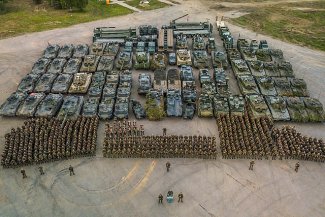The EU Rapid Deployment Capacity: political priorities and real needs

The Belgian Presidency of the EU Council, which commenced on 1 January this year, is prioritising the implementation of the objectives outlined in the Strategic Compass. This includes the initiation of EU rapid reaction forces, referred to as the EU Rapid Deployment Capacity (RDC), which will have a projected strength of up to 5000 soldiers by 2025. EU institutions believe that fulfilling this ambitious plan is a matter of great political importance. Josep Borrell, the EU High Representative for Foreign Affairs and Security Policy, has prompted member states to commit to providing the missing elements of strategic support known as strategic enablers, but some countries are hesitant to engage resources in an endeavour that prioritises the security needs of the EU’s south and stands in competition with NATO initiatives. The pursuit of political success inherent in the fulfilment of the Strategic Compass’s goals is likely to culminate in the creation in good time of the RDC. However, it may fall short of some of the envisioned resources and strategic enablers, which will raise doubts about how effectively it can be utilised in the future.
EU crisis management
Since the late 1990s, the European Union’s role in rapid civil-military management in its neighbouring regions has been steadily increasing. On one hand, this is a consequence of the diminishing significance of collective defence since the Cold War ended. On the other, it is closely tied to the emergence of new types of crises and conflicts, such as the wars in the Western Balkans or the operation of terrorist groups in the Sahel region. The aspirations of some member states to assert autonomy in such matters from NATO and the US have also played a significant role. This has created a demand for a limited contingent of forces capable of rapid deployment, relocation and conducting operations, such as carrying out evacuations or initiating stabilisation missions.
EU countries first decided to send a specific number of soldiers capable of stand-alone operations during the Helsinki European Council meeting in December 1999 (European Headline Goal).[1] Operation Artemis in the Democratic Republic of the Congo (2003) was the first autonomous EU-led crisis response operation. The experience of this operation gave rise to the concept of EU Battlegroups (EUBG) which reached full operational readiness in 2007.[2] The concept envisaged that member states would deploy in parallel two battalion groups of 1500 soldiers, for six months each time. The battlegroups should be initially sustainable for 30 days, and this period may be extended to 120 days.
The Strategic Compass and new ambitions
No EUBG has yet been used in crisis response scenarios, primarily due to the lack of political will on the part of the member states. There are also some issues concerning the Battlegroups that still need to be addressed, such as financing their potential operations, or the lack of key capabilities (the so-called strategic enablers), including reconnaissance and air transport, without which they cannot be used. All these problems have prompted EU countries to reform the EUBG.
The EU’s security strategy published in March 2022, known as the Strategic Compass, assumes that a modular Rapid Deployment Capacity (RDC) of up to 5000 troops, including maritime, air and land components (depending on the needs), based on a modified EUBG, will be established by 2025.[3] It would additionally be supported with strategic enablers tailored to suit the situation. The Strategic Compass envisages that the RDC should be ready to operate in two types of operational scenarios by 2025: evacuation and the initial phase of stabilisation operations in a non-permissive environment. The first type of operational scenario was inspired by the evacuation of military personnel and civilians from Afghanistan in the summer of 2021. The conclusion is that the EU should be able to conduct a similar operation on a much larger scale than it is capable of at present. The second type of operational scenario assumes a shorter and more intensive combat operation preparing the ground for a long-term stabilisation mission under the aegis of the UN, the EU or other international organisations. These scenarios mainly concern interventions in the EU’s southern neighbourhood, and prioritise the security interests of the EU member states located in the Mediterranean region. Therefore, the RDC has mostly been supported by these countries and those EU member states that are not part of NATO, as well as by those countries which treat the development of the EU Common Security and Defence Policy (CSDP) as a political priority.
The RDC concept places higher demands on member states than the EUBG.[4] The modularity of the RDC means that EU member states’ armed forces need to be flexible enough to deploy a component (air, marine or land) tailored to a specific operation. In addition, the number of troops on standby has been increased (now it is up to 5000 soldiers instead of two EUBGs of 1500 each), as has the duration of their deployment (one year instead of six months). In the course of preparations for RDC deployment, member states have committed to providing the necessary strategic enablers or developing them before 2025. The Strategic Compass lists the most important of these: strategic transport, force protection, medical assets, cyber defence, satellite communication and intelligence, surveillance and reconnaissance capabilities. The EU is currently considering an option whereby the ongoing revision of priorities for the Permanent Structured Cooperation (PESCO) instrument could be aligned with the objective of generating forces and resources for the RDC.
Regular exercises are planned in order to enhance the RDC’s combat readiness. The first exercise, MILEX23, took place on 16–22 October 2023 in Cadiz. It focused on replicating the initial phase of a stabilisation operation involving land, marine, air, space and cybersecurity components. Around 2800 soldiers participated, primarily from Spain (1800), France (600) and Portugal (200). MILEX23’s joint costs (€5 million) were covered by the European Peace Facility (EPF). Reluctance to maintain forces on standby for six months and only then to potentially deploy them was one of the reasons why the EUBG concept failed, as the expenses primarily burdened the states which contributed the Battlegroups. The Strategic Compass mandates EU countries to reassess the scope and definition of ‘common costs’ to enhance solidarity and encourage members to contribute their forces to the RDC. On the one hand the EPF, to which EU member states contribute proportionally to their GDP, seems to meet these requirements. On the other hand, this means that the RDC will be financed by all EU countries, but if deployed, it will be primarily used in its southern neighbourhood.
The RDC is also a pretext for EU institutions, and those member states which support the development of the CSDP, to promote the expansion of joint military command structures.[5] The Strategic Compass envisions that either national operational Headquarters or the Military Planning and Conduct Capability (MPCC) will be the command & control structures of the RDC. However, the latter is still in the preparatory phase, and some countries (such as France) want it to be more enhanced, which would require much more personnel to be deployed. In turn, the military personnel resources of the individual nations are limited, especially given the challenges linked with strengthening NATO command structures.
The deadlock in the decision-making process is one of the reasons why EU member states have thus far hesitated to deploy the EUBGs. In order to avoid a similar impasse with the RDC, the Strategic Compass proposes to “decide on practical modalities for implementing Article 44 of the Treaty on the European Union” to allow “a group of willing and capable” member states to conduct operations. Implementation of Article 44 requires unanimous consent from the EU Council, whereas the option of not participating in the operation (and thus not bearing its costs) would eliminate the decision-making deadlock. However, this approach contradicts the strengthened solidarity concept promoted by the Strategic Compass.
Challenges and prospects
The ambition to establish the RDC contrasts with the practical reluctance of EU members to utilise the already available common rapid reaction instrument – the EUBG. The provisions of the Strategic Compass regarding the RDC pose challenges that go beyond and require greater resources than those associated with the Battlegroups. Meanwhile, the progress made so far in implementing the RDC demonstrates a limited willingness to allocate resources to keep crisis response forces on standby, including crucial capabilities such as common logistics or air transport.[6] The fact that EU institutions have been treating the RDC as a flagship initiative reveals that a realistic assessment of the security situation in Europe, following the Russian invasion of Ukraine, has a lower priority than continuing the development of EU security policy instruments. Some member states are willing to accept far-reaching political commitments to underscore the EU’s ambitions in the field of defence, but are still refraining from implementing them after analysing the real needs and challenges. Another controversy concerns the intention to further communalise the costs of RDC operations and exercises (for example by using EPF funds, which are primarily intended for financing the needs of the EU’s partner countries).
Another major factor that prevents member states from committing their capabilities to the RDC is the existence of the NATO Response Force (NRF) and its proposed successor, the Allied Reaction Force (ARF).[7] Numerous member states have prioritised engagement within NATO, considering the role it plays in collective defence, while allocating additional capabilities to the EU is often technically impossible. In turn, the suggestion to allow the same forces to be committed to both the NRF/ARF and the RDC seems to be politically risky, as this may trigger conflicts between the need to deploy the NRF/ARF and RDC simultaneously in two different theatres. Suggestions from European institutions that the RDC could be used in Armenia, Moldova, Georgia or Ukraine[8] are currently unconvincing for the eastern and northern EU countries. It is hard to imagine that EU member states would be willing to deploy the RDC against Russia (a nuclear power) without NATO becoming involved or against Turkey – which is a NATO member. The need to expand EU commands also raises concerns, not only due to the risk of duplicating command structures at the national and NATO levels, but also considering the shortage of adequately trained officers needed at both levels (and now also at the EU level).
An alternative scenario to the EU implementing the RDC on its own would involve close cooperation with NATO in implementing the European rapid reaction capability as part of the new ARF force. This would help avoid the duplication of structures and the dilemma over resource allocation. The RDC, which in fact would be part of Europe’s contribution to the ARF, would fit with the declarations made on both sides of the Atlantic about building the ‘European pillar of NATO’. Furthermore, the use of NATO’s capabilities in EU operations, especially in the field of strategic planning, is envisaged under the Berlin Plus agreement of 2002.[9]
What stands in the way of implementing the RDC concept by 2025 are the different defence priorities of many EU countries. Postponing the deadline would avoid political disappointment. However, it is unlikely that the introduction of the RDC will be postponed or given up, considering the ambitions of EU institutions and some member states to strengthen the EU’s autonomy in the field of crisis management, partly due to the uncertainty concerning the situation after the US presidential elections in 2024.
Given the generality of the provisions of the Strategic Compass and the inflated expectations regarding the RDC, this instrument will most likely only have been declaratively implemented by 2025. It may also be lacking some of the proposed resources and strategic enablers, so in the end the EU member states will end up not using it.
[1] The European Security and Defence Policy: from the Helsinki Headline Goal to the EU Battlegroups, European Parliament, 12 September 2006, europarl.europa.eu.
[2] EU Battlegroups, European Council and Council of the European Union, April 2013, consilium.europa.eu.
[3] A Strategic Compass for Security and Defence, European External Action Service, 24 March 2022, eeas.europa.eu, pp. 25–27.
[4] D. Zandee, A. Stoetman, Realising the EU Rapid Deployment Capacity: opportunities and pitfalls, Clingendael Policy Brief, October 2022, clingendael.org.
[5] D. Fiott, L. Simón, EU defence after Versailles: An agenda for the future, In-depth analysis requested by the SEDE subcommittee, European Parliament, October 2023, cris.vub.be, pp. 14–15.
[6] A. Pugnet, ‘EU looks to convince countries to invest in crisis management force, top military chief says’, Euractiv, 24 November 2023, euractiv.com.
[7] J. Gotkowska, J. Graca et al, ‘NATO Summit in Vilnius: breakthroughs and unfulfilled hopes’, OSW Commentary, no. 526, 13 July 2023, osw.waw.pl.
[8] Defense. NATO. Diplomacy. Crises. Security. Powers, B2 Pro. The daily newspaper of geopolitical Europe, 25 October 2022, club.bruxelles2.eu.
[9] ‘Berlin Plus Information Note’, NATO, shape.nato.int.





